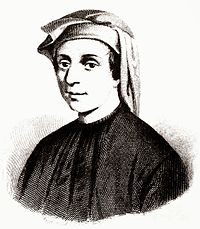|
Vikidia currently has 4,626 articles. Improve it! |
|
Join Vikidia: create your account now and improve it! |
User:Jojoco/sanbox
Leonardo Fibonacci
Résultat de recherche d'images pour "leonardo fibonacci"
Life: SANDRA
Born: (around) 1175, Pisa (Italy)
Died : (around)1250, Pisa (Italy)
profession: Mathematician
nationality : Drapeau de l'Italie Italian
Leonardo Fibonacci was an italian mathematician. He was born in Pisa around 1175 and died around 1250. He is possibly "the greatest European mathematician of the middle ages". he is known for his book Liber abaci (1202); and for popularizing the Hindu-arabic numeral system in Europe and the Fibonacci numbers. He was the son of Guglielmo Bonaccio. Whose job was to represent the people trading in Bugia today’s Bejaia, Algeria, North-Africa. So Leonardo grew up and studied in in North-Africa, and returned to Pisa around 1200 where he died.
STUDIES[edit | edit source]
It’s in Algeria, more exactly in the city of Béjaïa that Fibonacci began to study the mathematics and his father learned him quickly the Indo - Arabic calculation. He had the luck to travel a lot like in Egypt, in Syria (...) what allowed him to meet different mathematicians and get new knowledges around the mathematics.
http://www.universalis.fr/encyclopedie/leonardo-fibonacci/
Main work[edit | edit source]
Numbers
He was one of the first persons to introduce the Hindu-Arabic number system to Europe - the positional system we use today - based on ten digits with its decimal point and a symbol for zero:
1 2 3 4 5 6 7 8 9 0
Fibonacci Sequence
The original problem that Fibonacci investigated (in the year 1202) was about how fast rabbits could breed in ideal circumstances.
Suppose a newly-born pair of rabbits, one male, one female, are put in a field. Rabbits are able to mate at the age of one month so that at the end of its second month a female can produce another pair of rabbits. Suppose that our rabbits never die and that the female always produces one new pair (one male, one female) every month from the second month on. The puzzle that Fibonacci posed was...
How many pairs will there be in one year?
Here is an illustration to explain the problem:
We can see that the number of pair of rabbits we have every month gives a sequence. This is the Fibonacci Sequence : 0, 1, 1, 2, 3, 5, 8, 13, 21, 34, ...
This sequence is build in a manner that next number is found by adding up the two numbers before it.
•The 2 is found by adding the two numbers before it (1+1)
•Similarly, the 3 is found by adding the two numbers before it (1+2),
•And the 5 is (2+3)
•Etc...
The ratio of a number with the precedent (for example 34/21) approaches the golden ratio, which is approximately 1.618 and is found in the nature and in paints, sculptures,architecture, etc...
You can also make a spiral with the Fibonacci sequence, by putting side by side squares like this:
Afficher l'image d'origine
My part arrived here:
Anecdote:[edit | edit source]
during his life Leonardo Fibonacci has passed loads of time in the nature to observe all the animals. It’s this animals which have inspired the mathematician in his experimentations.
-With his famous sequence for example, which use a natural fact with rabbits. the reproduction of the rabbit month by month was a revelation of a repeating fact for Fibonacci.
-With the spirale of this sequence too. In fact, he had find a relation between the spiral form by the snail and the addition of the number of his sequence (by putting side by side squares). This relation is effectually a reality in the nature.
it’s very interesting to see the links between the fibonacci works and the natural events. It’s a work really mysterious of Fibonacci which is know and use all around the world. This work is the "golden ratio". This number mentioned in the part .... is so exeptionnal that it is still today a reference. It's by the division of two consecutive numbers in the sequence of Fibonacci that it's got like it's explain in the part .... . With this "magic" number, fibonacci had find how create optical illusions. With the observation of: the plants (especially flowers), the universe, the fingerprints, the naturals events (like the waves), Fibonacci had find relation mathematique which explain the naturals developments, phenomenas.
actually we know that it's also the travels of the mathematician in egypt, syria or Algeria which he had give relations, maths experiment or style of writing. of this journey born the Arabic calculation explained by Fibonacci. he have effectually find that the Arabic calculation was more adapted to the maths than other systeme. In the part .... it's possible to find what was the famous works of Fibonacci which had give him famous and which regroup the knowledges collected by the mathematician.
